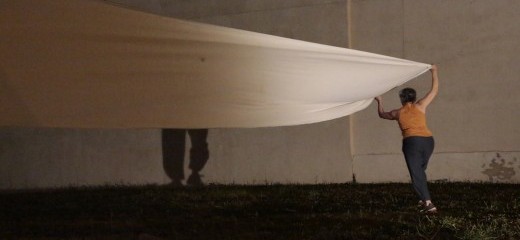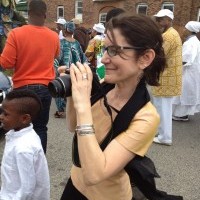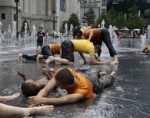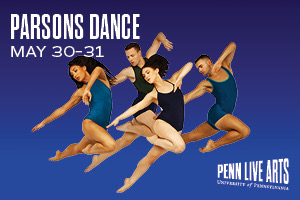
SaltSoul: Loss and Mourning, part 1
by Toni Shapiro-Phim
In the summer of 2013, dancer/choreographer Jungwoong Kim embarked on movement experiments that explored ways of uncovering “new life in found objects and the sound of what is left” after sudden material and human loss. He undertook this embodied investigation in response to the June 2013 collapse of a Salvation Army thrift store at 22nd and Market Streets in Philadelphia. Six people perished in the rubble: Anne Bryan, Rosaline Conteh, Bobor Davis, Kimberley Finnegan, Juanita Harmon, and Mary Simpson. Thirteen others were injured, one severely. Jungwoong had witnessed the tragedy. He had been biking home on that gorgeous day with not a cloud in the sky, riding along 22nd Street, when the ground shook. In an instant, where there had been buildings, there were piles of concrete, wooden beams, and broken bricks; where there had been friendly banter between customer and salesperson, there were sirens and, eventually, silence.
Beholding such a catastrophe in which futures were re-cast or wiped out, with no warning, triggered memories of personal loss: Jungwoong Kim was just ten years old when his father perished in a car accident. That was in South Korea, where Kim was born and raised. (He moved to the U.S. in 2008 and has been based in Philadelphia since 2010.)
Summer, his series of danced experiments, played with light and shadow under an overpass near the flattened thrift store, the sonic possibilities of security gates and chains and the texture of dirt and brick. It was imbued with frustration, confusion, anger, and grace.
Within a year, another horrific event would further impact Kim and, ultimately, his dance-making. In April of 2014, the Sewol Ferry sank off the coast of South Korea. Most of the 304 dead were school students on a field trip. People throughout South Korea, and Koreans the world over, grieved in public ceremonies. At Danwon High School in Ansan, Korea, a commemorative classroom remained, until it was removed in August of 2016, exactly the way it was when the ferry went down. Kim attended meetings of a Philadelphia-area Korean group concerned for the victims’ families who were looking for accountability.
Human error, incompetence, greed, and negligence factored into both the Salvation Army and the Sewol Ferry calamities. In the aftermath, the Korean government’s opacity added insult to unfathomable injury.
Compelled to engage through his art with such heart-wrenching incidents (including the death of his father) and their legacies, Kim began by writing. “It was very challenging to share that deep story. I shared it for the first time, and it surprised me because … just writing father was something like a relief. Immediately, there was a shift in my body.… After [age] 10, I had had no chance to say or write the word father.” He then invited a crew of accomplished collaborators to work with him on developing ways to address, even if just momentarily, the devastation of sudden, irreparable loss by confronting lingering questions and intense emotions, nurturing empathy, and fostering connections. His allies in this endeavor include dancer-choreographers Germaine Ingram, Marion Ramírez, and Merián Soto, musician-composers GaMin Hyosun Kang (known professionally as gamin) and Bhob Rainey, and experimental videographer/visual artist Fred Hatt. Kim asked me to be this new project’s documentarian. As such, over the course of this past year, I’ve observed and recorded rehearsals and performances, and conducted interviews with participants.
“Disasters – both near and distant – change us in ways that escape words. Loss reveals truths about ourselves and the ties that connect us,” Kim has written. Through this project, which he has entitled SaltSoul, he aims to invoke a “shared sense of self-awareness and community in times of mourning,” and to rouse sensibilities and cultivate bonds across distance and difference. This has resulted in two performances in public places in the summer of 2016. One of these is documented below. A culminating piece will be presented October 6, 7, and 8 at the Asian Arts Initiative. SaltSoul has been supported by The Pew Center for Arts and Heritage.
July 7, 2016 pop-up performance: 22nd and Market Streets
Just inside the fence surrounding the cleared ground where the Salvation Army store once stood, Kim placed himself with his back to the street. He was standing on a few loose bricks remaining on the land. A small projector threw video images onto his back, visible to the audience of passers by starting to gather. He could sense people watching him, but then, as he explained, “an unexpected sensation” reached from the bricks, through his feet and up through his body. It brought out unanticipated movement and sound from within. He found himself vocalizing a call from the earth, as his arms lightened and lifted.
The 40-minute piece that unfolded involved the deep resonance of the taepyeongso, a double-reed wind instrument often played in Korean folk music and marching bands, performed by gamin, an award-winning composer and musician brought in from South Korea just for this project. She led a procession from beneath the earth – inside and then up the stairs of a subway tunnel – along the periphery of the site to the opening in the fence through which she, the other dancers, and the audience eventually entered the grounds. gamin joined with saxophonist Rainey to create a woodwind soundscape that accompanied explorations of light and movement, all honoring the lives that had been eclipsed.
Kim and his partners Ingram, Ramírez, and Soto, in various pairs, created brilliant sculptural yet fluid shadows on the wall of the parking garage, a wall completely exposed since the building collapse, by manipulating a 9-yard-long white cloth, moving closer to and farther from the light source. Both the cloth and the shadows seemed to breathe, growing huge and then tiny, and then huge again. The shadows, Kim reflected afterwards, might have been an extension of the earth: “Maybe they weren’t our shadows,” he said, implying that they may have referenced those who had perished there. The shadows seemed to evoke the releasing of their souls. “We didn’t expect that, but it happened. It was something spiritual.”
The fabric was then laid on the ground. Rolling along its length, the dancers’ bodies moved in sync on top of one another—and then took off individually with bursts of energy, communicating both intimacy and separation. Ramírez explained to me that in rehearsal they “had been stacking bodies over bodies which was starting to have resonance.” She had watched videos of the debris of the collapsed building, and began making connections between the stacking of bodies and the stacking of items in the rubble. For her, “the fabric began to contain that experience” of connection, as well as the experience of leaving somebody behind as one rolled over and moved on. Ingram adds that there were special moments of eye contact after one performer rolled over another. “And then that person departs and you stay behind. It happens with another, and then another.” The loss is visceral.
Kim: “It’s like in the immediate aftermath of the collapse. There were piles of clothes. Big chunks of a wall. And one shoe stuck under a piece of the wall. One body that cannot move. But when that person has passed, the spirit leaves the body, looks around and then departs.”
Eventually, in the performance, Kim is left to struggle alone, encased in that same cloth.
Kim: “This work is similar to what happens when you prepare to draw with a traditional Korean pen. You grind the ink. The white paper is blank. When you first touch the paper with the ink, the paper absorbs it, and it spreads. That space [at 22nd and Market] was empty. I felt that our work in that space was akin to dropping the ink. When our piece [movement, light, shadow, sound] touched the space, it was immediately absorbed” in unanticipated ways. The site then becomes animated. “The feeling comes that the space is still alive, awaiting our touch. It is now different from how it was before. I believe that space is going to be happy about what we did. We gave it one more chance to speak to the public. After our performance the space’s energy changed, and let go.”
Ramírez: “Jungwoong had been thinking about that space for three years. And within days after this performance, they started construction on a memorial right there.” It was time.
Kim goes on: “It would be dangerous for me to have anticipated what this would look like for the audience. I trust my collaborators and trust what I’m doing. I want to do what the space tells me to do.”
Ramírez: “I talked to [one man in the audience] who said we had awakened the alchemy of the space. The stone becoming dust when a body lands on it and dust rising in the air. The fabric made the wind that’s already there visible, tracing actual corners of the building that had been there.”
Ingram: “Nancy and Jay Winkler, parents of a 24-year-old disaster victim, were present. Nancy sent me an email message in which she wrote that, ‘The performance was very deeply moving.… So often people say, “there are no words” when they try to acknowledge the terrible loss we have experienced and the trauma of that loss. Your dance really was better than words.’ Her husband Jay said he had been ‘completely drawn into the feeling of it.’ That feeling really came out of Jungwoong’s aesthetic and training and the relationship of our collective exploration to space, light and time. People who knew nothing about that aesthetic, but had a strong emotional attachment to that space, could feel that presence—it spoke to their anguish, and their need and search for meaning.”
The acknowledgment of anguish and of the possibility of deep empathy courses through all elements of this SaltSoul project. * The second article in this series can be read here.
________
* This is the first part of Toni Shapiro-Phim’s reflection on the background and pop-up performances preceding SaltSoul.
Toni Shapiro-Phim is a cultural anthropologist and dance ethnologist. She is Director of Programs at the Philadelphia Folklore Project, a local arts and social justice organization.
SaltSoul http://www.saltsouldance.com/home.php at the Asian Arts Initiative, 1219 Vine Street, October 6, 7, and 8 at 8:00 pm. Tickets http://saltsoul.brownpapertickets.com/ . Additional performance within art installaton, habitus, of Ann Hamilton at Municipal Pier 9, 121 North Columbus Blvd., Oct. 9, 7 pm, free.
By Toni Shapiro-Phim
October 1, 2016







